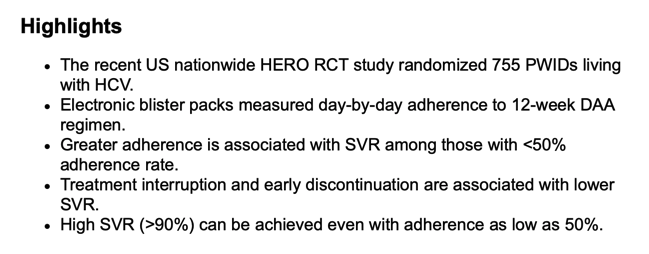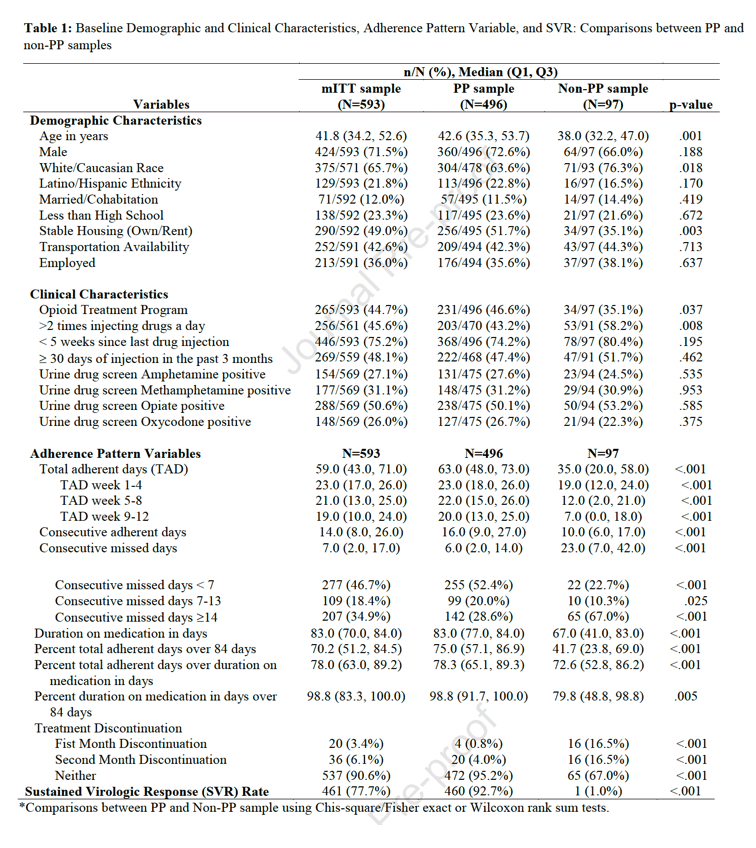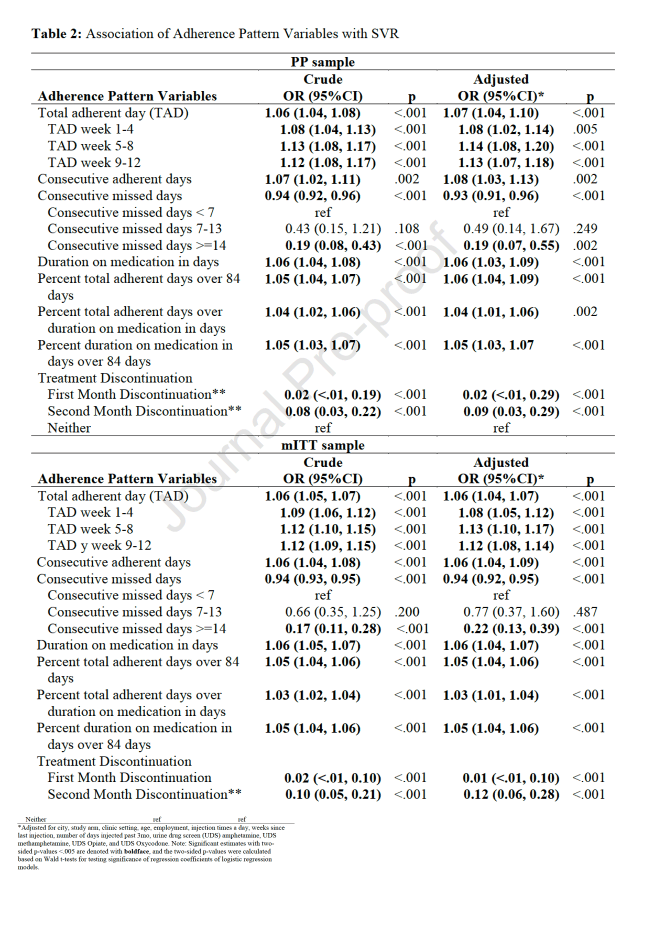| |
Optimal Hepatitis C Treatment Adherence Patterns and Sustained Virologic Response. among People Who Inject Drugs: The HERO Study
|
| |
| |
Download the PDF here
Jan 2024

Abstract
Background
Direct-acting antivirals (DAA) are highly effective for treating hepatitis C virus (HCV) infection even among people who inject drugs (PWID). Yet, little is known about patients' adherence patterns and association with sustained virologic response (SVR) rates. We aimed to summarize various adherence patterns and determine their associations with SVR.
Methods
Electronic blister packs were used to measure daily adherence to once-a-day sofosbuvir/velpatasvir during the 12-week treatment period among active PWIDs. Blister pack data were available for 496 participants who initiated DAA, and had ascertained SVR status. Adherence was summarized in multiple patterns, such as total adherent days, consecutive missed days, and early discontinuations. Thresholds for adherence patterns associated with >90% SVR rates were also determined.
Results
The overall SVR rate was 92.7% with median 75% adherence rate. All adherence patterns indicating greater adherence were significantly associated with achieving SVR. Participant groups with 42/84 (50%) or more adherent days, or less than 26 consecutive missed days achieved >90% SVR rate. When adherence was stratified by <50% versus ≥50%, only among those with <50% adherence, greater total adherent days during 9-12 weeks, and no early discontinuation were significantly associated with higher SVR rate. Participants with first month discontinuation and ≥2 weeks of treatment interruption had low SVR rates, 25% and 85%, respectively. However, greater adherent days were significantly associated with SVR (aOR = 1.10 (1.04, 1.16), p<.001) even among participant with ≥14 consecutive missed days.
The observed SVR rates were 460/496 (92.7%, 95%CI = (90.5%, 95.0%)) and 461/593 (77,4%, (74.2%, 81.0%)) for the PP and mITT samples, respectively, despite overall median adherence rates of 75% and 70% respectively. (Table 1). Figure 1 depicts DTF adherence over 84 treatment days in the PP sample and the Supplementary Figure S4 in the mITT sample, showing that participants with no SVR had smaller number of adherent days especially at the later stage of the treatment period.
Although distributions of baseline demographic and clinical characteristic and all pattern variables are comparable between the mITT and PP samples (Table 1), the non-PP sample was significantly younger, more White participants, more marginally housed, less treated in OTP, more times injecting drugs a day, and worse in all adherence patterns compared to the non-PP sample (Table 1).
In conclusion, low adherence to DAA during a 12-week treatment regimen among PWIDs is common. However, patients with suboptimal adherence as low as 50% are able to achieve high SVR rate >90%. For patients with poor adherence (i.e., <50%), greater adherence is still important for increasing likelihood of achieving SVR. In addition, treatment interruptions of at least 2 weeks and early discontinuations are associated with lower SVR rates. Interventions targeting improved adherence could be most useful to offer to those who demonstrate poor adherence early on in treatment. In sum, greater total adherent days, longer consecutive adherent days, and shorter consecutive missed days all can ensure 90% or higher SVR rate, and a lower threshold of missed days does not make a difference. Encouraging and supporting patients to take as much medication, with less than 2 weeks consecutive misses, and without early discontinuation, defined as discontinuation in the first and/or second month, is important for achieving HCV cure.
In a large geographically diverse sample of PWID, we found that improved adherence to various patterns of DAA self-administration were all significantly associated with achieving SVR, regardless of the PP or mITT sample. Greater total adherent days, longer duration on medication, longer consecutive adherent days, and shorter consecutive missed days are important patterns that could ensure successful SVR and should be emphasized in patient adherence conversations. These findings extend prior findings on electronic blister pack adherences and SVR from the PREVAIL trial and the SIMPIFY trial.
It is worthy to note that greater total adherent days were significantly associated with SVR only among the subgroup of participants with <50% adherence rate.
Although these studies focused on PWID, the HERO study recruited significantly more participants, which is likely the largest sample size to date of active PWID injected within 3 months of enrollment.


| |
| |
| |
|
|
|